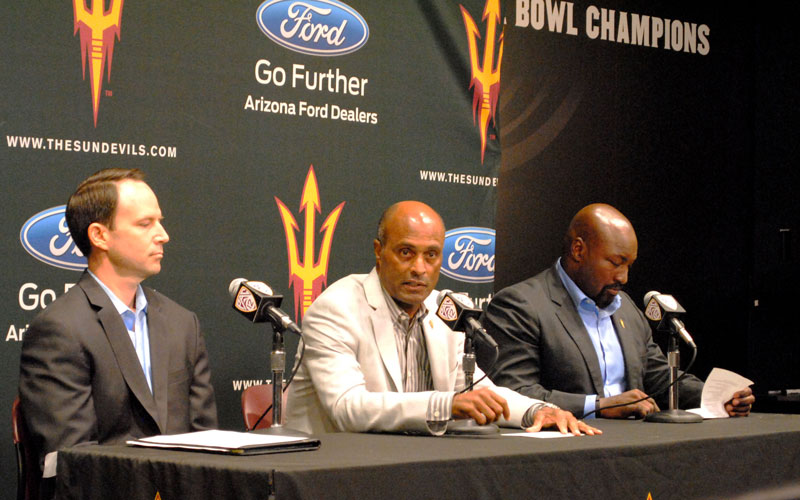
Arizona State Vice President for University Athletics and Athletic Director Ray Anderson (center) and senior associate athletic directors Rockey Harris (left) and Scottie Graham (right) anounce the additions of varsity women’s lacrosse and triathlon to the university. (Photo by Bill Slane/Cronkite News)
TEMPE– Arizona State became the first Power Five conference school Tuesday to elevate triathlon to a varsity sport.
At a news conference Tuesday morning, ASU Vice President for University Athletics and Athletic Director Ray Anderson announced the addition of women’s triathlon and women’s lacrosse to Arizona State’s varsity roster, the 24th and 25th varsity sports at the Pac-12 school. The Pac-12 is one of the Power Five conferences in college athletics, along with the SEC, Big 10, Big 12 and ACC.
There has been a significant increase in women’s triathlon participation across the country over the past 15 years. Female membership in USA Triathlon has gone up 400 percent during that time and there are currently to 189,018 female members, according to Sun Devil Athletics.
Bettina Warnholtz, a running and triathlon coach and founder of Arizona’s Racelab, says she has about a 50-50 split between women and men that she currently coaches.
“There have been many program geared toward women and encouraging them to start,” Warnholtz said. “There are also many races that are just for women.”
ASU currently has club teams for both women’s triathlon and lacrosse, so the transition will be similar to the transition for the men’s hockey program, which began play at the varsity level earlier this month.
“This is another exciting day for Sun Devil Athletics,” Anderson said. “I just love these moments. I love it for our student-athletes and I love it for our university.”
Anderson, along with senior associate athletic directors Rocky Harris and Scottie Graham, thanked Don Mullett and an anonymous donor for the $32 million they pledged to help elevate the hockey team to a varsity program last year. When that money was pledged, the donors made it clear to Anderson and ASU that those resources were also meant to help the university add more women’s sports.
“Because that’s the right thing to do and university-wise that will allow you to meet your obligations under the very necessary and very appropriate Title IX legislation,” Anderson said.
ASU also received a $140,000 grant from USA Triathlon in April to help elevate the program to a varsity sport. ASU was one of 10 schools to receive such a grant from the organization. Those grants have been part of a larger effort from USA Triathlon to develop the sport at the collegiate level.
Harris pointed to a program that USA Triathlon started in 2009 when it targeted collegiate runners and swimmers and worked with them to become triathletes after college. One of those athletes, Gwen Jorgensen from the University of Wisconsin-Madison, is now the top female triathlete in the world.
“I think for us, we can’t want until they graduate college to start training them,” Harris said. “By bringing triathlon (to) Division I athletics it gives us four years to train these future Olympians.”
Warnholtz has come across several members of the ASU women’s triathlon club team in the past and has seen some of them continue with the sport and succeed after college, but thinks taking the “club” label off the team will be beneficial.
“Sometimes the club can seem more like a recreational thing and I think that if schools give it the importance of becoming an official sport, it motivates the girls so much more,” Warnholtz said.
Anderson and the university hope to draw more Olympic athletes to Tempe by adding sports like triathlon and improving other Olympic sports at the university.
“We think this community, led by Arizona State, should be the national spot where you think of Olympic training,” Anderson said.
To do that, they have to start training future Olympians at a younger age. Wanholtz has been training young athletes in Arizona for years, but the country’s first Power Five triathlon team is a good next step.
“If they have a program in schools that takes them seriously and provides the quality of training, quality of competition, and all of that, it opens up a completely different opportunity for them, for the schools and then for the country,” Warnholtz said.